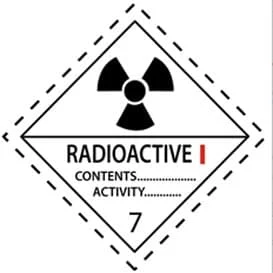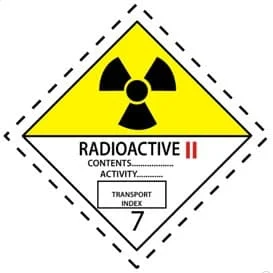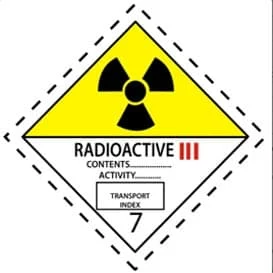Before we start talking about the transport of class 7 dangerous goods, I will give you a simple overview of some of the daily uses of radioactive materials for those who are less familiar with them. Radioactive materials are used in several fields to improve the quality of life, and they are used by qualified personnel to ensure that radioactive materials are prepared, transported, used and disposed of in a safe manner.
I will give you an example where Dangerous Goods Class 7 is used, radioactive materials are used in nuclear applications in medicine for the purpose of diagnosis, treatment and disease management. They have many uses in animal production such as insect control and animal production enhancement ... etc.
Note : By reading this article, we recommend that you read previous Dangerous Goods Class 6. Or click here for all list of dangerous goods articles.
What are radioactive materials?
Dangerous goods which are classed as radioactive material are defined by the dangerous goods regulations as any material containing radionuclides where both the activity concentration and the total activity in the consignment exceeds certain pre-defined values.
Note : A radionuclide is an atom with an unstable nucleus and which consequently is subject to radioactive decay.
Is Dangerous Goods Class 7 having a packing group?
Before answering this question, I need to give you an idea about the meaning of "packing group", it is an indication of the relative degree of danger presented by various articles and substances within some dangerous goods classes or divisions. Usually, dangerous goods regulations give roman numerals as the following:
I for high danger
II for medium danger
III for low danger
Now, I can answer this question, packing group not apply to this Dangerous Goods Class. There are special packing requirements for class 7 dangerous goods. Packing requirement donate the maximum activity (quantity) limits for these packages types.
You may ask!
Is there division within Dangerous Goods Class 7, Radioactive Materials?
● Radioactive Materials Category I - White [RRW]
● Radioactive Materials Category II - Yellow [RRY]
● Radioactive Materials Category III - Yellow [RRY]
Lets start.
Radioactive Material Category I - White [RRW]
Radioactive material with low radiation level on the package surface. No transport index indicated.
Not more than 0.005 mSv/h (0.5 mrem/h) |
Transport index
0 Zero |
Category | IATA IMP CODE |
Category I - White | RRW |
 |
| Category I - White [RRW] | Radioactive Placard |
Radioactive Material Category II - Yellow [RRY]
Maximum surface radioactive level in mSv/h (mrem/h)
more than 0.005 mSv/h (0.5 mrem/h) but not more than 0.05 mSv/h (50 mrem/h) |
Transport index
More than 0 but not more than 1 |
Category | IATA IMP CODE |
Category II - Yellow | RRY |
 |
| Category II - Yellow [RRY] | Radioactive Placard |
Radioactive Material Category III - Yellow [RRY]
exceeding 1 but not more than 10.
Maximum surface radioactive level in mSv/h (mrem/h)
more than 0.05 mSv/h (50 mrem/h) but not more than 2 mSv/h (200 mrem/h) |
Transport index
More than 1 but not more than 10 |
Category | IATA IMP CODE |
Category III - Yellow | RRY |
Radioactive material fissile Criticality Safety Index
You can help us promoting aviation safety by sharing
Criticality safety index labels must be used in addition to the appropriate radioactive labels to provide control over accumulation of packages or overpacks containing fissile material
 |
Fissile material | Radioactive Placard |
This video will explain the class 7 dangerous goods, radioactive materials in a simple way.
You can help us promoting aviation safety by sharing this article. And you comments is highly welcomed.


